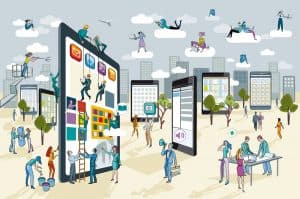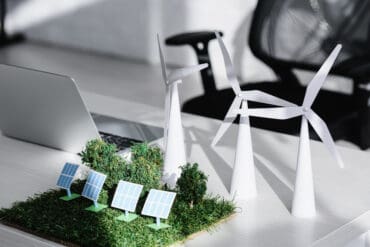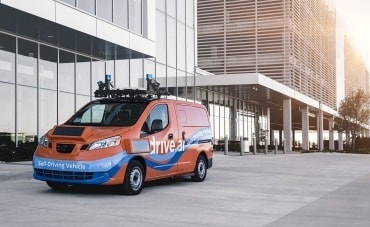
Many businesses find they need a common development platform for their varied real-time smart applications that aid them in getting back to work.
Businesses preparing for employees to return to work find they need many new smart systems based on real-time technology. Specifically, they will need systems that help protect employees and visitors if business is truly going to return to something close to the days before the pandemic. The diversity of the needed systems and applications makes matters complex and implementation challenging.
Smart systems will cover almost every aspect of operations. For example, they will likely be used even before people are invited back to work. A past RTInsights article on how AI enables predictive containment management explored the work being done by healthcare organizations and academic researchers into AI-based predictive models to forecast the spread, severity, and end of the COVID-19 crisis. Some of that work centered on using a reinforcement-learning AI framework for helping cities and regions make policy decisions about lockdowns, closures, and physical distancing in response to pandemics like COVID-19. The author speculated that this framework, which relies on AI-based simulations, might be adapted for use by private organizations trying to optimize their lockdown and work-from-home strategies.
Back to work
Whether such a model is used or not, let’s assume people will be going back to the office in months to come. Past RTInsights articles and a study by Deloitte identified multiple areas that companies are focusing on, and some suggested smart technologies that could help. They include:
Social distancing aids
Here the challenge is how to monitor distancing, provide guidance to workers, and enforce policies all in real-time. Solutions to help with social distancing might use a variety of technologies, including:
- Screening: Smart thermometers could measure an employee’s temperature before entering a building and automatically deactivate their building pass if the person is deemed a risk.
- Location suggestions: Businesses might use carpet with embedded lighting to give employees visual clues about where to stand in a room.
- Proximity sensing: Embedded in smartphones and wearables, proximity sensors would provide personal digital assistants data with real-time information about crowding conditions.
- Computer vision: Smart cameras using AI to observe crowds could deliver information to applications such as occupant counting and wait-time metering and send alerts when people move too close to each other indoors or out in public.
Facilities management aids
Cleaning will be imperative when employees return to work. What is needed goes well beyond the typical overnight washing of floors and wiping down counters. Now, businesses must repeatedly clean facilities throughout the day. Solutions in this category might use technologies, including:
- Smart scheduling: After every gathering, the room used needs a wipe down to help prevent the COVID’s spread. A smart scheduling solution might help. Reserving a conference room or meeting space would automatically alert facilities management and schedule a cleaning after the meeting breaks up.
- Mobile app guidance: Cleaning crews will no longer stick with a schedule as they did before the pandemic. They will need to clean areas after each meeting and respond on-demand to any situation that warrants additional sanitizing. Facilities management departments might use mobile apps to direct cleaning staff to their next assignment.
- Confirmation and documentation: Facility management departments will find that they will constantly be scrambling to sanitize surfaces and rooms based on use by employees throughout the day. Tracking that work might be out of the realm of legacy systems that simply have a crew punch in and punch out and do not track work done. Businesses might implement a smart system that uses QR codes throughout the office to track the cleaning timing and frequency.
Air quality, ventilation, and environmental management
Many smart buildings already have tied building management systems and HVAC systems together, automating systems to maintain a comfortable office setting for employees. Now, more is needed, including:
- Automated ventilation: Sensors must measure more than temperature. A business might want to use air quality sensors to measure levels of CO2, VOCs (volatile organic compounds), and other pollutants. If levels rise, a smart system might automatically increase ventilation in specific parts of the building.
- Occupancy-dependent ventilation: Airflow is an important element in reducing the risk of infection. That’s why many states and cities allowed outdoor dining while prohibiting or severely limiting indoor dining. As employees return to work, businesses may look for solutions that mimic the benefits of the outdoors. A system that could increase airflow and boost ventilation dynamically based on the number of people in a room might be useful.
- Sensor-based air cleaning: Many businesses are deploying improved air filtering systems and UV and white light disinfection systems. Businesses could turn such systems into smart systems using air quality data and automation based on that data and occupancy levels.
Bringing real-time systems together
Many of the suggested individual systems above require great amounts of development work to build and manage. They are comprised of smart sensors and the Internet of Things devices, and data collection and analysis solutions. Any insights derived from the data must then be conveyed and shared with legacy building and facilities management systems.
Developing a smart application by integrating the sensors, data, and legacy applications is time-consuming. Simply developing an app is no longer enough. Businesses must constantly update applications to incorporate new data sources, analytics routines, and new features and capabilities.
Take that work and multiply it by ten, a hundred, or a thousand. That’s what would be needed to implement the dozens or more real-time smart applications described above.
What many businesses will find is that they need a common development smart applications development platform. Such a platform will provide any smart application with easy access to sensor or other data, rather than reinventing the wheel every time a new application development effort is undertaken. For example, some companies are tackling these issues with solutions such as the Back-to-Work Accelerator from VANTIQ.






